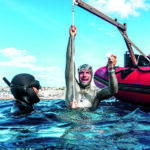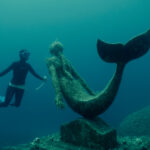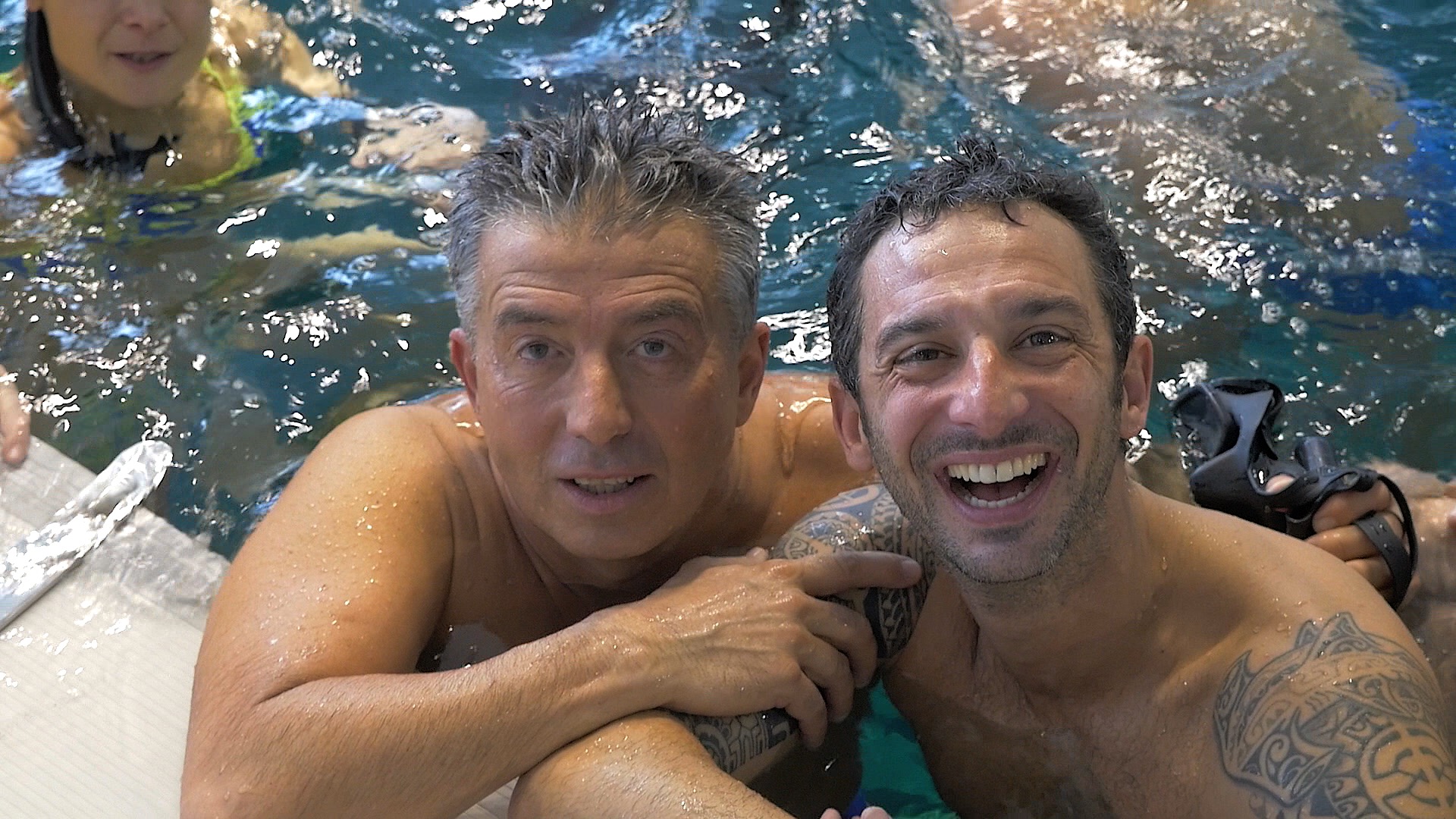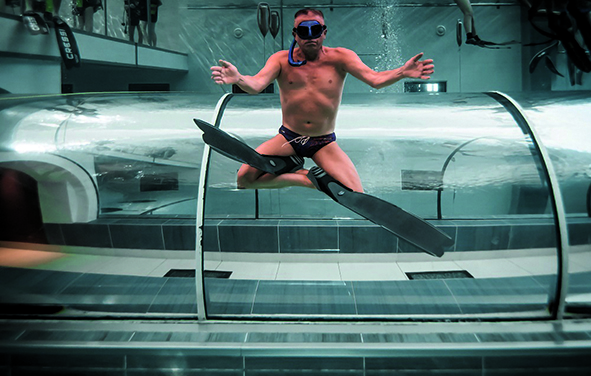Marco Mardollo, Mr. Y-40

Ocean Freediving Lanzarote
24 April 2024
How does our mind work? Keyword: awareness
26 April 2024He is the technical director of the Montegrotto pool, as well as the co-founder of Apnea Academy. The difficulties of managing "traffic" in water and the qualities that he believes distinguish a good instructor
Filippo Carletti
If you have ever entered Y-40 in Montegrotto Terme, you have surely crossed paths with him. Perhaps it happened in the pool, as he meticulously observed the freedivers on the cables, or maybe in the corridors and the bar, where he bounced between one water session and another. Marco Mardollo is history and culture, wisdom and passion, but above all, he is the founding father of an important part of modern and contemporary freediving.
Hello Marco, today you are the technical director of Y-40, co-founder of Apnea Academy, and, naturally, a freediving and scuba diving instructor. How did you get into freediving?
"As a young man, I was a good swimmer and had excellent water skills. Then, like many, I drifted away from swimming because I found it repetitive and boring. During that same period, I happened to try a course with a friend of my dad's, who was a scuba diving instructor. Those who were already practicing it were all lacking from a swimming perspective, and I quickly became passionate about going underwater. In '69, scuba diving was hybrid. It allowed both freediving and diving with tanks, leaving the latter for the final part of the course. So, I took many courses, went on vacation in Greece, and freediving started to take a prominent place in my life. At that time, people dived without much knowledge, but for those who could move well in the water, 25 to 30 meters were quite achievable goals. That's how I started, and I continued teaching in Padua, during my high school years, where I slowly realized that scuba diving with tanks was too rigid, too schematic, and that I wanted to dedicate myself completely to freediving. And so, I came up with the idea of organizing an advanced freediving course. In these courses, inviting various athletes, I met the rising star Umberto Pelizzari, with whom we started exchanging ideas and news. I always said that I would like to create something new, perhaps a federation. He, on the other hand, said that it already existed and that it would be nice to simply create a school. In those years, during a world record attempt, Umberto experienced a taravana on ascent from the dive and had to stop for a few months. During this time, we stayed in touch, continued to communicate, and one day the phone rang: "I've been thinking, it could be a good idea," he said. "Let's try it! There's also someone from Genoa who has proposed something similar. Why don't we meet?" And so, Apnea Academy was born".
What does Padua have to do with it, and how did Y-40 come about?
"You have to consider that there are various types of instructors. There are those who teach, those who organize, those who deal with certain things, and those who deal with others. In Padua, I started with Umberto and Nicola Sponsiello, a nutritionist, passionate about freediving and a great underwater fisherman. We all had excellent knowledge and became a reference team. Regarding the mental and psychological aspect, Lorenzo Manfredini entered instead of Luigi Odone. As Apnea Academy, we started in '94. It was me, Umberto, Renzo Mazzarri, and Angelo Azzinari. There was also Luigi Magno for the physiology part, Sponsiello for dietetics and nutrition, Odone, and Mauro Ficini. The latter were responsible for the scientific part of the project. In fact, the first instructor course we organized on Elba Island took place in 1995, but the meetings and preparations had already started a year earlier. We had taken into consideration, probably for the first time, relaxation and breathing together with the mental aspect and physiology. The great awareness that distinguished us from the beginning was to perceive freediving not only as a discipline but also as an activity of well-being. In fact, we divided relaxation and breathing sessions in thermal centers from dynamic sessions and physical preparation. Before us, static was never conceived as an element of pleasure and well-being. Just as, today, Y-40 is the only dedicated underwater center in Italy that is usable 12 months a year, in any weather. Whatever happens, it is the reference point for those seeking depth".
And how did Y-40 come about?
"In 1982, I was teaching as an instructor at a club in Padua. One of my students was the son of the owners of a thermal hotel. One day, while taking a shower, I heard him say, "I'm not very good at dressing at the bottom, I'll try again at home." Obviously, we all burst out laughing. Later, he invited us to the Millepini hotel, and from that moment, we started organizing evenings together within the structure. In 2011, he called me and said, "Hello, how are you? I'd like to talk to you about something." "What do you want to do, a spa? Nice." "No, no," he replied, "I want to build the deepest pool in the world." As he was finishing the sentence, I was already in the car to meet him. We talked a bit. In the meantime, I had remained active as an instructor, I had stayed updated, always on the ball, and so what I learned is that a month later, they would start construction. But not only that. I had been chosen to oversee the technical aspects and safety of the new facility. Since 2012-2013, I have been working at Y-40 and taking care of the technical aspect, including regulations, safety, and equipment".
What does it mean to have such an important role in one of the temples of modern freediving?
"It's a great satisfaction, although it comes with passions and difficulties. The main problem arises when there are too many requests and all for the same spaces. The pool has 40 spots, so when a considerably large group arrives and takes it all for themselves, then it's easy to distribute and manage. But when, instead, there are days when everyone wants to go to 40 meters, then it becomes a problem. Even the dive preparation is not straightforward. Some people ventilate too much, some don't have the technique to use the well, and some are simply inexperienced for certain depths. I often suggest ventilating away from the cable and having the buddy bring you only when ready. In general, it's always good for large groups to divide between deeper and shallower areas. Also, as many already know, it's absolutely forbidden to enter the water without a buddy, or venture into caves while freediving, or not use the lanyard and computer".
How was the Mardollo test born and what other tests exist?
"The test was born as a check of physical fitness and parallels the usefulness of the cooper test for running. It counts how much distance one can cover while freediving, with recovery in motion. The total distance is the result of how trained an athlete is, provided they commit and give their all in those 12 minutes. The real comparison is always with oneself and can indicate both the level of training and whether the equipment change is functional for us or not”.
What does improvement mean and why does it seem there's more focus on equipment than on training?
"When people go skiing, they rely on fancy skis, even if they can't use them. The same happens in freediving. 70 percent of practitioners, even though they dive deep, don't know how to fin. And maybe I find €400 fins at their feet. The fact that a freediver goes to 40 meters doesn't indicate that they're good, but that they have sufficient strength and training. There are people who have truly Herculean strength, but maybe they dive with a terrible posture and unwatchable finning. If they had the right adjustments and the correct attention, they would shine. Many then invest in compensation, which certainly gives you many meters. But finning well, moving well underwater, you can easily reach the same depths. At Y-40, you can reach the bottom even with €20 fins; it's a technical matter. Of course, I know it's more tiring, but the true skill of the freediver is knowing how to start relaxed and having excellent breath control”.
Since you meet dozens of them every day, what characterizes a good instructor?
"There are so many instructors, and as the years go by, the number increases exponentially. But alas, the level is not so high. The real skill lies in understanding the difficulties of the student and providing the right advice to help them solve them. Some time ago, I witnessed a lesson where an instructor returned to the surface with the student and advised them to open their legs at 22 degrees during finning. Then with the next student, he gave the same advice. And I was thinking about how these students should know what 22 degrees felt like. He had learned to say this thing and repeated it to everyone. To be good, you have to personalize expectations and abilities, just as it's important to choose advice and examples based on the person and the problem".



